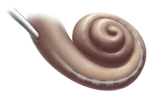NIH-funded Research on Shape of Cochlea Is One of Discover's Top 100 Science Stories of 2006

Research partly conducted by the National Institutes of Health (NIH) has been named by Discover magazine as one of the top 100 science stories – and one of the top two math stories – of 2006 in its January 2007 issue. The research, conducted by Richard Chadwick, Ph.D., National Institute on Deafness and Other Communication Disorders (NIDCD), and Emilios K. Dimitriadis, Ph.D., NIH Office of Research Services, working in collaboration with Daphne Manoussaki, Ph.D., Vanderbilt University, helps explain why the cochlea is spirally shaped, similar to a snail's shell. Their paper is published in the March 2, 2006, online issue of Physical Review Letters.
Using a simple model of a spiral, the research team calculated how the cochlea's curve affects the movement of sound energy inside the inner ear. They found that sound energy preferentially travels along the outer wall of the cochlea, improving the ability of sensory cells to convert sound energy into electrical signals that are interpreted by the brain. Because the effect is greatest at the center of the spiral, where the lowest sound frequencies are detected, this enables us to hear low-pitched sounds better.
Read more about Dr. Chadwick's research. Read more about Dr. Dimitriadis's research. Visit the Discover Web site.